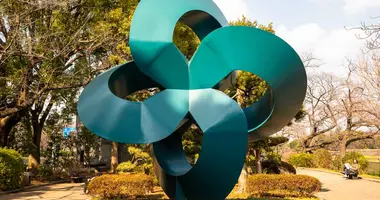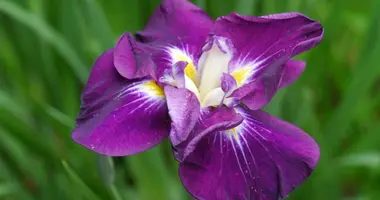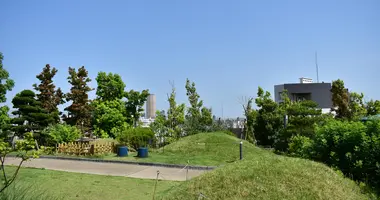Kyu-Shiba-rikyu Gardens
Kyu-Shiba-rikyu Onshi Teien. Read a guide to Kyu-Shiba-rikyu Onshi Teien, or the Shiba Detached Palace Garden in Tokyo's Hamamatsu-cho business district.
Kyu-Shiba-rikyu Gardens 旧芝離宮恩賜庭園
Kyu-Shiba-rikyu Onshi Teien. Read a guide to Kyu-Shiba-rikyu Onshi Teien, or the Shiba Detached Palace Garden in Tokyo's Hamamatsu-cho business district.
 Kyu-Shiba-rikyu Gardens, Tokyo
Kyu-Shiba-rikyu Gardens, Tokyo
This gem of a garden, translated as the "Shiba Detached Palace Garden," is, along with Koishikawa Korakuen Garden, one of Tokyo's few surviving clan gardens from the Edo Period.
Kyu-Shiba-rikyu Gardens is an oasis of serenity and elegance in the hardfaced, small-business milieu of the Hamamatsu-cho area. It is also only a short walk from nearby Hama Rikyu Gardens and both attractions can easily be seen in half a day.
History
 Kyu-Shiba-rikyu Gardens, Tokyo
Kyu-Shiba-rikyu Gardens, Tokyo
The garden is on land reclaimed from Edo Bay in the late-1650s. It began in 1678 as the landscaped residence of Tadatomo Okubo, an official of the ruling Tokugawa Shogunate.
The original garden, called "Rakujuen," was designed by landscapers from Okubo's home fiefdom of Odawara (present-day Kanagawa Prefecture). It went through many changes of ownership.
In 1871 Kyu-Shiba-rikyu Gardens became a residence of the Arisugawa-no-miya family (see Arisugawa-no-miya Memorial Park). Four years later Kyu-Shiba-rikyu Gardens was purchased by the Imperial Household Agency when it became the Shiba Detached Palace.
After destruction in the fires of the Great Kanto Earthquake of 1923, it was given to the city of Tokyo, which restored the grounds and opened it as a public garden in April 1924. Kyu-Shiba-rikyu Gardens was designated a nationally significant scenic and historical treasure in 1979.
Layout
 Kyu-Shiba-rikyu Gardens, Tokyo
Kyu-Shiba-rikyu Gardens, Tokyo
Kyu-Shiba-rikyu Gardens' focus is a large pond known as Sensui in which there are two small islands, the main Nakajima, which is accessible by a bridge, and the smaller, isolated Ukishima.
Sensui Pond is inspired by Lake Xi Hu in Zheijiang, China, which was famous for its concentration of holy men living around it, and for the holy mountain nearby it that was said to impart eternal youth. The mountain is represented on Nakajima with rocks.
The highest point in the gardens is formed by the Oyama hill. It forms a chain with smaller hills (or, more accurately, mounds) either side of it.
Just in front of Oyama hill, at the side of the pond, is Karetaki, the "waterless waterfall."
There is a wisteria trellis near the entrance, and, just beyond it, a Japanese archery (kyudo) range. (Note that anyone wishing to practice archery there must bring all their own equipment.)
An interesting feature of Kyu-Shiba-rikyu Gardens is the surrounding urban landscape of gleaming highrise towers. They contrast strangely with the otherworldly, bygone air of the gardens, but by no means unsettlingly.
The flora has something to offer whatever the season, the greatest variety on display being in autumn thanks to the numerous trees that color. The garden is also known for its spring azaleas and cherry blossoms, summer irises, and winter apricots and narcissi.
 Kyu-Shiba-rikyu Gardens, Tokyo
Kyu-Shiba-rikyu Gardens, Tokyo
Hours
Open 9 a.m. to 5 p.m. (last entry at 4.30 p.m.)
Admission
150 yen.
Access To Kyu-Shiba-rikyu Gardens
 Stone lantern (toro), Kyu-Shiba-rikyu Gardens, Tokyo
Stone lantern (toro), Kyu-Shiba-rikyu Gardens, Tokyo
From JR Hamamatsu-cho station, north exit, 1 minute.
From Daimon station (Oedo subway line), exit B2, 2 minutes.
From Daimon station (Asakusa subway line), exit B2, 2 minutes.
From Takeshiba station (Yurikamome line), 7 minutes.





























